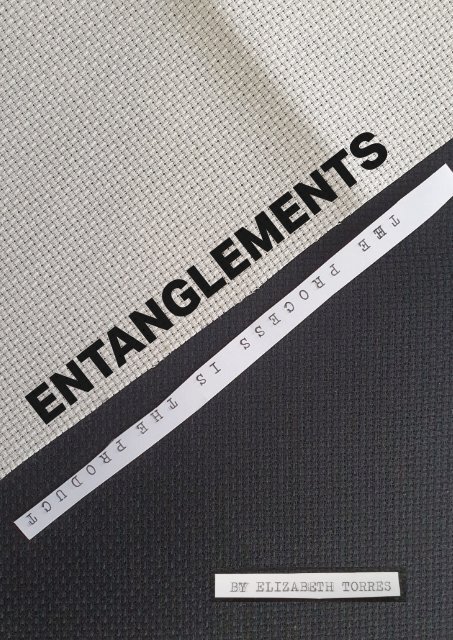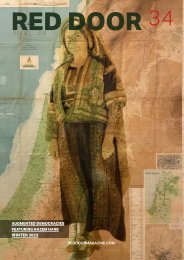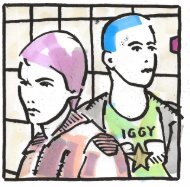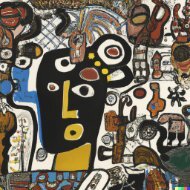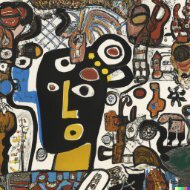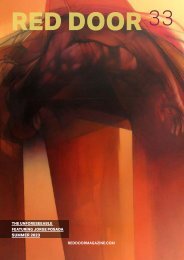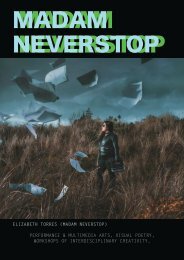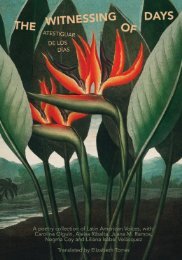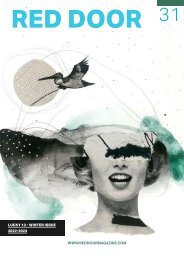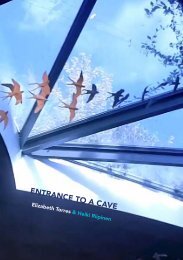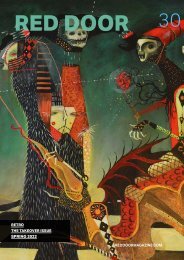ENTANGLEMENTS
A multimedia digital publication for Den Danske Scenekunstskole by Elizabeth Torres, 2022 MFA portfolio, spring 2022
A multimedia digital publication for Den Danske Scenekunstskole by Elizabeth Torres, 2022
MFA portfolio, spring 2022
Erfolgreiche ePaper selbst erstellen
Machen Sie aus Ihren PDF Publikationen ein blätterbares Flipbook mit unserer einzigartigen Google optimierten e-Paper Software.
<strong>ENTANGLEMENTS</strong><br />
01
02<br />
Entanglements<br />
A multimedia portfolio<br />
by Elizabeth Torres<br />
Den Danske Scenekunstskole, 2022<br />
ISBN 978-87-94003-08-7<br />
Red Press, Copenhagen, DK<br />
All rights reserved by the artist.<br />
www.delegationforthefuture.com
<strong>ENTANGLEMENTS</strong><br />
<strong>ENTANGLEMENTS</strong><br />
<strong>ENTANGLEMENTS</strong><br />
03
TABLE OF CONTENTS<br />
INTRODUCTION<br />
SPECIALIZATION<br />
-Play as System<br />
-Playwriting Masterclass<br />
-Suspending Disbelief<br />
-The House of<br />
Oscillations<br />
PROGRAM MODULE<br />
-Futures Literacy<br />
-Alexandria Nova<br />
-Artistic Response<br />
-Artistic Research<br />
INTERNSHIP<br />
-Teater Grob<br />
-ActInArt: Estonia<br />
-Red Thread<br />
PERSONAL JOURNEY<br />
-La Loteria: Nocturnal<br />
Sweepstakes<br />
<strong>ENTANGLEMENTS</strong><br />
GLOSSARY<br />
BIBLIOGRAPHY<br />
04
05
<strong>ENTANGLEMENTS</strong><br />
06
07
PLAY AS SYSTEM<br />
An ongoing masterclass with Sarah<br />
Woods.<br />
The purpose of creating a system, or<br />
establishing a series of systems (better<br />
yet, recognizing them) when writing<br />
a play, is all about giving ourselves<br />
choices.<br />
Sarah explains that apart from seeking<br />
purpose, a system allows us to set<br />
parameters, understanding if what<br />
we’re doing is useful, why it is so, and<br />
where it is going.<br />
The basic ingredients of a play are:<br />
-Plot: The why/how – What we choose<br />
to show<br />
-Theme: Which helps define the<br />
structure and rhythm<br />
-The structure: Which Sarah defines<br />
as the tupperware that contains all our<br />
elements<br />
-Characters: who<br />
-Story: What<br />
-Dialogue: the transitions on how we<br />
get there.<br />
Sarah explains that acts are like the<br />
tupperware divisions of a play, which<br />
divide not just the length but also<br />
define the beginnings and ends, and<br />
help us shift and define connections<br />
and relationships.<br />
Acts and scenes, she continues, are<br />
individual transactional moments of<br />
wants and needs. An understanding of<br />
where you will be placing drama, and<br />
the rhythm.<br />
Plot and theme are revelation: These<br />
elements can be removed from a play,<br />
but you must know how to do so, so<br />
as to replace them while maintaining<br />
fluidity and their role<br />
in the play.<br />
Question:<br />
Where do we<br />
tend to start<br />
our stories/process?<br />
08
Stories we are told<br />
A workshop with Sandra Buch<br />
Pay attention to the types of stories in the<br />
plays and scripts you see. These can often<br />
be divided into the 9 stories:<br />
Cinderella: Unrecognized virtue at least<br />
recognized.<br />
Achilles: The fatal flaw (classic tragedy)<br />
Faust: The debt that must be paid. (A fact<br />
that catches up).<br />
Tristan: Triangular plot.<br />
Circle / Spider & the Fly: The chase. (Typical<br />
detective story).<br />
Romeo & Juliet: Win, lose, win back. Classic<br />
love story.<br />
Orpheous: The gift taken away. (Justification<br />
for loss). Justice as closure.<br />
Hercules: Hero adventure that keeps<br />
going. Redemption story.<br />
Jacob & Esau: The rivaling siblings.<br />
Think about stories you would like to telll<br />
and how you would tell them based on<br />
these 9 structures.<br />
What to look for in a story? BACKBONE!<br />
How do the stories you are excited about<br />
fit when told in each of these formats? Do<br />
they give new perspectives?<br />
PLAYWRITING MASTERCLASS<br />
In applying this information<br />
to the work of my own play,<br />
I am able to define the<br />
type of story I am writing: A<br />
combination of Orpheus and<br />
Romeo & Juliet.<br />
I draw the structure of my play<br />
in the form of its actual setting,<br />
where the house is the past,<br />
the present the beach and the<br />
future the outskirts.<br />
The characters are 4, with<br />
a multimedia entity in the<br />
background and the other 3<br />
which I represent as dolls so as<br />
to be able to ‘talk to them’ and<br />
meet them, to understand their<br />
needs.<br />
I define themes as identity,<br />
grief and displacement, and<br />
as seen below, begin to mark<br />
the roles that each of the parts<br />
play, which facilitates the writing<br />
process because from then on,<br />
everyhing has a purpose.<br />
09
“Theater theaters everything in. So our job is to shove something<br />
down its throat every now and again that it cannot swallow.” – Brecht.<br />
A masterclass with poet, playwright, director and performer<br />
Marc Von Henning<br />
010<br />
SUSPENDING DISBELIEF<br />
Marc spent a few days in Århus with the<br />
Writing specialization giving a masterclass<br />
on the importance of form, language, and<br />
reality in theater. He explained that there<br />
are 4 fundamental elements of theater:<br />
-The visible / visual: content<br />
-The audible: sound, music, (and yes,<br />
dialogue)<br />
-The language / intellect: associative<br />
narrative, storytelling<br />
-Audience: Interpreters of feeling. The<br />
processors of the three other elements, who<br />
in their minds complete their story.<br />
Marc went on to speak on the textualizing<br />
of forms, which can be done in many ways,<br />
some of which are:<br />
-Double monologue.<br />
-Dialogue<br />
-Reenactment (which Mark especially<br />
recommended because he explained, this<br />
makes an audience feel like they’re being<br />
taken seriously. They can either get lost<br />
in the story, or return to the room and be<br />
marveled at the actors performance, the<br />
setting, etc… They’re “in” on the plot.<br />
-Translation:<br />
Marc explains that bilingual texts provide<br />
2 sides to every story, and that one should<br />
look at languages as an aesthetic idea,<br />
from surtitle to live interpretation. He<br />
recommends looking at language from<br />
an insular perspective, which allows for<br />
understanding of tradition and environment.<br />
“We are often made of more than one thing.<br />
We’re often trying to reduce it, so as to<br />
understand.” he poetically explains. Then<br />
he continues: “Like playing an instrument,<br />
writing is also about the notes you do not<br />
play.”<br />
Systems have a price, a value.<br />
Steering towards: rationality, function,<br />
associations, repetitions, composition,<br />
compilation.<br />
The poems that stay close, are the ones you<br />
don’t understand.
Afterwards we learn of his past work,<br />
including that of Primitive Science, and how<br />
his main interest has been to focus on telling<br />
stories or highlighting stories all around us,<br />
or more importantly, to make his audiences<br />
aware that we all have stories, that we are<br />
often in search of making sense of them, and<br />
this is how we also make sense of where we<br />
are going, our connections, and do plenty<br />
of stargazing along the way (looking at the<br />
past, making predictions of the future).<br />
Question: How to engage an audience by<br />
giving the audience problems?<br />
The idea of discomfort to help articulate an<br />
idea, lead to meaning… the what, not the<br />
how, is the beginning.<br />
Question: How to relate to an audience?<br />
How to treat them? what to make them<br />
feel? how to involve them / affect them /<br />
touch them?<br />
A construct: build a connection – provoke a<br />
response.<br />
Marc highlighted that there is no need<br />
of knowing what one needs to say, but of<br />
knowing there is something to be said.<br />
Putting direct opinions across misses out on<br />
good material for stage.<br />
The wonder of obsession and alternate<br />
mind can open bigger connotations.<br />
Stories are like tasks. They’re modules.<br />
Models for other stories.<br />
<strong>ENTANGLEMENTS</strong>: secrets we keep from<br />
ourselves.<br />
Hidden agendas.<br />
THE BEGINNING: Work from inside out.<br />
From a concept. a phrase. A part of a<br />
story. Fashion everything around a moment<br />
that needs to happen. An image where<br />
the image originates. The claim of being<br />
someone else.<br />
When writing a play, build a tight set of rules<br />
that cannot be broken, but are open in that<br />
one can be free within them.<br />
-Find this form and fill it with content.<br />
-Authenticity can come, f.x, from a talk w an<br />
actor to learn what moves them, and writing<br />
based on these needs, a role that connects<br />
with these emotions.<br />
APPROACH: Writing for a person or<br />
character specifically, moulding the story to<br />
them.<br />
CONTEXT: Juxtaposition. Personality traits.<br />
Duality. When we fall in love, we learn to see<br />
ourselves in the eyes of others.<br />
IMITATION: Until you know your own voice,<br />
take something we all know and give it a<br />
different context. The pep-talk, the magic<br />
act, etc.<br />
Take the audience on a journey and let<br />
them choose their involvement. Remove<br />
some of the ground so the audience gets to<br />
be invested in the investigation of the truth<br />
behind the story.<br />
SEPARATION OF BODY AND VOICE:<br />
Influenced by Bunraku Japanese puppet<br />
theater, is a method Marc is very passionate<br />
about. In this type of theater, the stage is<br />
divided in four parts.<br />
CONTENT: Veer away from causes, opinion,<br />
things that point out the obvious. Tolerances<br />
and contradictions can be questioned<br />
without patronising an audience.<br />
OBJECTIVE: To break the usual standards<br />
and build one’s own new structures. Recipes<br />
for new thought.<br />
LISTS: the use of lists to make connections<br />
from irrational or uncommon territories to<br />
thread them together.<br />
LETTERS: There are different types of letters,<br />
Marc explains, the epic (episodic) where<br />
audience learns something, or aristotelean,<br />
where the character learns something.<br />
LECTURE: The format of a lecture for a<br />
performance is interesting because, just<br />
like in a TED talk, the audience is already<br />
convinced or in favor of the subject being<br />
discussed, and rather than needing to be<br />
persuaded just wants to be pushed deeper<br />
in.<br />
The realness of storytelling brings truth to<br />
any story, Marc concludes.<br />
011
PLAY: THE HOUSE OF OSCILLATIONS<br />
Would you like to come<br />
home?<br />
012
My play, The House of Oscillations,<br />
combines various subjects I am very<br />
curious in studying further: The<br />
fluctuation of identity, the coming<br />
and going of memory, the spaces<br />
in between dream and reality where<br />
our truths take new forms and allow<br />
us to fully “see” ourselves.<br />
This being my first play, I needed to<br />
be able to “meet” my characters so<br />
as to relate to them and understand<br />
what they needed to say, so I created<br />
dolls out of the 3 main characters,<br />
ACHERON, LETHE, and MELINOE,<br />
and had them sit by me during the<br />
writing process.<br />
Two of my characters, LETHE and<br />
MELINOE,, are entrapped in ideas<br />
of belonging, in processes of selfdiscovery<br />
and the realization of<br />
being connected to the same story<br />
although in different parts of the<br />
timeline.<br />
ACHERON, on the other side,<br />
literally, is really good at pinpointing<br />
everyone else’s weaknesses but his<br />
own: the fact that he can’t let go and<br />
doesn’t dare to cross the river to the<br />
underworld.<br />
My fourth character, ERYTHEA,<br />
is actually a projection that takes<br />
place during small intermissions of<br />
the play, to provide insight, poetic<br />
relief or simply a moment of beauty.<br />
So as to image this character I<br />
created a video titled “ERYTHEA<br />
SPEAKS”, which is to give the sense<br />
of red space, mental affirmation and<br />
mysticism that my character carries<br />
in each of her appearances.<br />
I envision the setting of this play<br />
as in a beach, with an old house<br />
serving to tell parts of the story.<br />
The moments of the past are<br />
represented within the house, the<br />
present on the outside, digging<br />
truth from the sand, and the future<br />
/ unknown being represented in the<br />
river, the waters and that which we<br />
cannot see. As the play progresses,<br />
the house of oscillations begins to<br />
break down, fall apart, and slowly<br />
tumble to reveal a new self, ready<br />
to comfront the painful parts of life<br />
that had blocked happiness from<br />
entering and settling.<br />
Below, the video ERYTHEA SPEAKS,<br />
to set the mood. (and text on next<br />
page).<br />
013
Vision I<br />
Erythea is all red seas and red fabrics and red sands.<br />
When Erythea speaks it is your flesh speaking, commands<br />
vibrating and resounding in the room as if in a dream.<br />
What is it?<br />
what is it you are looking for?<br />
is it something you lost?<br />
something you left behind<br />
something you cannot pinpoint<br />
with your eyes closed?<br />
does it have a shape?<br />
a name?<br />
a location?<br />
014<br />
How does it taste<br />
once you let it simmer in your<br />
mouth?<br />
What is an adjective?<br />
Epitheton is adjective in Greek<br />
it means placed on top,<br />
appended, foreign.<br />
The visible roots of the structure.<br />
The connections beginning to<br />
be made.<br />
If you water them, they will<br />
begin to bloom.<br />
A whole language, bursting<br />
from your tongue<br />
the name of everything<br />
horse<br />
shallow<br />
bird<br />
sinister<br />
memory<br />
anger<br />
flood<br />
fragment<br />
citation<br />
survival<br />
see it?<br />
When you say blood, what color<br />
does it have?<br />
When you say BLOOD, which<br />
direction does it flow to?<br />
When I say BLOOOOOD!!! from<br />
whose heart is it spilling?<br />
Epitheton<br />
as if to say attachment<br />
and you would think these<br />
small additions<br />
would pass unnoticed<br />
but adjectives are what color<br />
the story<br />
adjectives are how the world is<br />
presented<br />
how we know what codes to fill<br />
our mind with<br />
to see what you see<br />
try it:<br />
empty handed<br />
hollowed womb<br />
outside herself<br />
deep agony<br />
sudden truth<br />
premonition<br />
do you begin to see it?<br />
do you begin to see it?
ERYTHEA SPEAKS<br />
The structures come out of the<br />
flesh<br />
from the concave parts of the<br />
skin<br />
and spit out small roots<br />
thirsty for water<br />
but what is water if not a<br />
realization<br />
what they are looking for, you<br />
see,<br />
within the sand,<br />
within the hollowness of you<br />
an attachment<br />
and adjectival tradition<br />
a light that might as well blind<br />
but instead chooses to be<br />
miracle<br />
a word, yes, a word<br />
one you forgot a long time ago<br />
but which tonight could save<br />
you.<br />
foreign<br />
foreign<br />
foreign<br />
you are an adjective<br />
in you the precise combination<br />
of sounds<br />
that can make from all the noise<br />
a place.<br />
There are many ways to tell a<br />
story,<br />
and yet your heart chose to tell<br />
it like this.<br />
Why do you think that is?<br />
shelter<br />
shelter<br />
shell<br />
shallow<br />
shore<br />
shadow<br />
shhhhhhhhh.<br />
Why do you think that is?<br />
015
THE FUTURE<br />
“Crisis, violence,<br />
unemployment...<br />
globalization, economic<br />
imbalance, insecurity,<br />
social orphanhood,<br />
misery...<br />
-Listen, my friend...<br />
You can’t spend your days<br />
anxious about the fears of<br />
our current world.<br />
Why don’t you try taking<br />
a walk through the frights<br />
that the future promises?<br />
You’ll see! What a relief to<br />
be back in the present!”<br />
Cartoon by Joaquín Salvador<br />
Lavado Tejón, (1932 - 2020)<br />
better known by his pen name<br />
Quino, an Argentine-Spanish<br />
cartoonist popular in many<br />
parts of the Americas and<br />
Europe, praised for his use of<br />
social satire as a commentary<br />
on real-life issues.<br />
A popular internet<br />
meme using the Toy<br />
Story characters to<br />
represent the common<br />
anxiety that takes over<br />
once the sci-fi images<br />
of “the future” recede<br />
and the reality of how<br />
it might relate to the<br />
present settles in<br />
the brain. Inequality,<br />
class division and the<br />
uneven distribution of<br />
goods make it difficult<br />
for some to take time off<br />
to imagine.<br />
016
017
018
“All theatre is political in the sense that theatre is not autonomous and is forced<br />
continually to decide in whose service it acts.” – Sandy Craig (Unmasking the lie).<br />
019
The woman in the water<br />
an audio novella by Elizabeth<br />
Torres, Tabita Friis Kisrtensen,<br />
Heiki Eero Riipinen and Anja<br />
Bothe.<br />
020<br />
Iron - by Tabita, Anja and<br />
Elizabeth.<br />
Workshop with Inger Eilersen.<br />
This workshop was inspired<br />
and heavily influenced by the<br />
photographic creations of<br />
Gregory Crewdson, American<br />
artist recognized for his<br />
elaborately staged scenes of<br />
small town American life. His<br />
photographs have dramatic<br />
and cinematic qualities, and he<br />
often has an extensive support<br />
crew on site for proper staging<br />
and lighting.<br />
Inger provided a series of<br />
Crewdson’s photographs, and<br />
on the first day asked us to<br />
go through the images and<br />
begin asking questions about<br />
it, based on the information<br />
received. For example, of this<br />
picture, one might ask, “Why<br />
did the time stop at 5:05?” or<br />
“What type of pills are those<br />
on the table?” or “Where are<br />
the father and child of those<br />
photos?”. Afterwards we<br />
divided in groups and began<br />
to do in-depth studies of<br />
the characters in the photos,<br />
starting to imagine narratives<br />
and interactions.<br />
On the following days we<br />
began to get acquainted with<br />
Artistic Research methods<br />
taken from Das Art.<br />
We used the following<br />
feedback formats:<br />
Statements of meaning:<br />
What has meaning about<br />
what you have just seen<br />
or experienced? What was<br />
stimulating, surprising,<br />
evocative, memorable,<br />
touching, unique, compelling,<br />
and meaningful to you?<br />
Performers Perspective:<br />
The performer says before<br />
showing, what she/he wants out<br />
of this session. The performer<br />
formulates a specific question<br />
that they would like to get<br />
feedback on.<br />
Affirmative Feedback:<br />
Give only positive feedback<br />
under the headline: This<br />
worked for me.
Responsibility of the facilitator:<br />
Points of attention.<br />
What makes sense in what you have been<br />
presented to.<br />
What is stimulating, surprising, moving,<br />
impressed, attracts you, makes sense or<br />
appears unique, etc. Start<br />
talking about it in a positive light.<br />
The question of the idea?<br />
A specific question is asked by the creator<br />
that he / she would like an answer to from<br />
the group. It is an idea<br />
that the facilitator communicates with the<br />
creator before the feedback round.<br />
The facilitator can help identify the<br />
question through several new questions –<br />
not through answers.<br />
Neutral questions from the group for the<br />
study:<br />
The group can ask factual and clarifying<br />
questions to the idea. Try to formulate<br />
opinions as neutral<br />
questions. Encourage the creator to find<br />
his own way, and do not tell them how to<br />
improve their ideas<br />
through your opinion.<br />
4 “Gossip” round.<br />
The group can only speak as if the author<br />
is not there. You imagine what is being<br />
said is not being heard by<br />
the owner. Talk free!<br />
Tips and Tricks (Associations)<br />
1) Support the exploration with something<br />
you know. Related to a book, a person, an<br />
art experience, a<br />
technique, an experience, etc. 2) add<br />
ideas and suggestions that you came to<br />
think of.<br />
The personal letter:<br />
The group can write individual thoughts<br />
about the idea in a letter. Give your time<br />
to do it – so it’s possible to relate to it<br />
later in the round.<br />
Write the sender on the letter so the<br />
owner has the opportunity to return for<br />
further talk about the contents of the<br />
letter.<br />
Point & wave effect<br />
A detail of something that made particular<br />
impression or based on that particular<br />
starts with one in the group, the reflection<br />
continues through the group based on a<br />
detail in the previous statement. It s like a<br />
relay effect.<br />
021
ARTISTIC RESEARCH<br />
Post 033 - On Artistic Research<br />
A workshop facilitated by<br />
Sarah Woods &<br />
Rikke Lund Heinsen, DDSKS.<br />
Q: In which ways do you use<br />
reflection in your work?<br />
Rikke explained that there<br />
are two types of positioning,<br />
which she called 1st and<br />
2nd position, and which I<br />
interpret as 1 being personal<br />
perspective and 2 being<br />
distanced and referencial<br />
perspective, that is to say, a<br />
zoomed in and a zoomed out<br />
view of the work being made.<br />
Questioning refers to open<br />
and innovative or different<br />
questions, as in looking at the<br />
object of interest from new<br />
angles so as to pull the right<br />
questions.<br />
Then there’s listening which<br />
is establishing a point of<br />
view and attitude based on<br />
the environment and the<br />
perspective gained.<br />
Mapping is the work and<br />
journey visualized, stages and<br />
difficulties of the process.<br />
Lastly, contextualizing is the<br />
acknowledgement of the work<br />
in relation to the world, its<br />
exploration and practice.<br />
022<br />
When speaking of Artistic<br />
Research, the word research<br />
should be treated like entering<br />
a new space, deepening<br />
and expanding knowledge,<br />
seeking. Prias must be kept<br />
in mind, as well as sensing,<br />
conversing and experiencing<br />
in-flux. Investigations and<br />
conclusions are important, but<br />
not conclusive.
Research can be personal or<br />
referencial.<br />
It can be professional, like<br />
networking or building an<br />
archive of info, and it can be<br />
academic by using inquiries to<br />
establish “new knowledge”,<br />
which is substantial new<br />
insights in the field.<br />
Practice as research<br />
creates the shortest path<br />
to knowledge. My way of<br />
understanding this is by<br />
relating to it through my own<br />
artistic process of constantly<br />
creating, researching, creating,<br />
returning to investigation, and<br />
by doing so creating a circular<br />
movement that feeds content<br />
to itself.<br />
As a result of artistic research,<br />
there will always be a product,<br />
a record or documentation of<br />
the process, complimentary<br />
writing and framework of<br />
influences.<br />
In expanding the glossary,<br />
knowledge is seen as an<br />
understanding of the back<br />
story, location and subject in<br />
history / lineage / field of work.<br />
Experience is liquid<br />
knowledge that runs through<br />
our system.<br />
Hard knowledge is read,<br />
learned.<br />
Bodily, tactile, etc is embodied<br />
knowledge.<br />
The more we dive into the<br />
field of Artistic Research, the<br />
more I relate to it in my work<br />
of always documenting and<br />
creating from the information<br />
around me. This leads me to<br />
decide to do my final project<br />
on the subject.<br />
023
INTERNSHIP<br />
During my internship period I collaborated with<br />
Teater Grob, a theater based in Nørrebro, which<br />
is currently focusing on expanding its repertoir<br />
to offer plays that engage in conversations on<br />
diversity, inclusion and human connection.<br />
I chose this partnership after a suggestion by<br />
Inger Eilersen, coordinator of the internships<br />
at DDSKS, who explained that not only was<br />
the director of the theater, Sargun Oshana an<br />
Alumni of Den Danske Scenekunstskole, but<br />
also the theater is located 2 blocks away from<br />
my gallery Red Door in Nørrebro, which would<br />
create a great possibility of expanding my<br />
local community and networking with other<br />
creators also interested in BIPOC and LGBTQI<br />
representation in our industry.<br />
The conversations were not only in-depth<br />
and very moving, but touching the subjects of<br />
shame, of uncertainty, of ageing, and allowed<br />
me to thread my own process to the ways these<br />
writers work on their plays, making it more<br />
approachable and familiar as a territory of work<br />
for my future creations. I am very grateful for<br />
the work GROB is doing and for the kindness<br />
and support with which they welcomed me.<br />
To learn more of the festival and its<br />
programming, visit:<br />
https://www.grob.dk/forestilling/pinkpavilion-2022-2/<br />
Due to both my and their busy schedules,<br />
we agree that the internship would be mostly<br />
remote, and arranged a series of meetings<br />
for check-ins throughout, with the rest of our<br />
communication done via email. After a series<br />
of brainstorming sessions, we agreed that<br />
the most fruitful way to collaborate would<br />
be through me doing a series of podcasts<br />
with their playwrights for this year’s PINK<br />
PAVILION, a festival which promotes emerging<br />
playwrights through small production of workin-progress<br />
plays and features the diversity of<br />
the voices in the playwriting community. This<br />
would help me in understanding the behindthe-scenes<br />
process of each play and writer, as<br />
well as help them make their festival known<br />
in a more international manner, through a<br />
collaboration that would conclude in the<br />
publication of a chapbook or official booklet<br />
of the PINK PAVILION festival, and a series of<br />
sound clips and interview episodes for them to<br />
promote the festival in the future.<br />
You can listen to these conversations via<br />
my podcast, Red Transmissions, which can<br />
be found on Spotify, Apple, and most other<br />
podcast providers, or simply by following this<br />
link:<br />
024
025
THE RED THREAD<br />
From march 31 to April 6 I coordinated an initiative I<br />
temporarily named “Red Thread” during the previous<br />
stage of applying for funds and recruiting participants.<br />
The idea of this call was to create an alliance amongst<br />
cultural organizers / performers / publishers in the<br />
Nordic region, whose work is connected to literature<br />
in Nordic languages or migrant languages in Nordic<br />
countries. The vision being the idea of creating a<br />
platform for the visibility of the stories and work of<br />
people writing and performing in languages that<br />
are not the primary language of the Nordic countries<br />
they reside, so as to provide translation and support...<br />
while simultaneously promoting Nordic “texts”<br />
through their translation to other Nordic countries<br />
and international languages that might expand their<br />
audience.<br />
Although we’re all publishers, and many of us are<br />
poets, the focus was on multimedia arts and<br />
performance, as we see this as the direct<br />
link with an audience to bring texts to life.<br />
The participating countries were Sweden<br />
Denmark Norway Iceland and Finland.<br />
A chapbook in over 10 languages<br />
celebrates our first meeting:<br />
026
Thanks to an Opstart grant by Nordisk Kulturfond<br />
I was able to host these international characters<br />
in Copenhagen, representing the following<br />
organizations: OsPressan in Iceland, Litteraturcentrum<br />
KVU, Tranås at the Fringe and Kultivera in Sweden,<br />
PEN, Bokens Hus and Runoviikko poetry festival in<br />
Finland, Capelens Foslag in Norway and Red Door,<br />
Tremella Radio and the Poetic Phonotheque in DK.<br />
Dominic Williams from Write4Word in Wales, joined<br />
us as an international affiliate thanks to the support of<br />
Wales Councii of the Arts.<br />
During our networking events we also hosted a public<br />
performance evening at LaFee Verte in Copenhagen<br />
where we all performed and invited others to join us,<br />
also hosting an auction with donations from artists<br />
and local businesses, raising 1500 euros for Ukrainian<br />
artists and Doctors without Borders.<br />
At my gallery, Red Door, we hosted a hybrid event<br />
which screened performances live from Copenhagen<br />
and simultaneously from Wales, as well as digitally<br />
with people joining us from many other countries,<br />
including the National Poet of Wales, Ifor ap Glyn.<br />
Creating such hybrid events allows for the inclusion<br />
of artists with neurodivergence, disabilities, and<br />
participation of both local and international<br />
audiences.<br />
After our series of meetings we officially established<br />
Red Door as an international alliance of collaboration<br />
and support, with an additional focus on the education<br />
of our own members through the exchange of the<br />
knowledge we each already acquire. I am now in the<br />
process of documentation and application of further<br />
grants to begin organizing greater events, shows and<br />
publications.<br />
One last surprise that came from this event was<br />
receiving an entire exhibition brought from Wales<br />
by an artist who’s been documenting domestic<br />
abuse and femicide in the country during the COVID<br />
pandemic. I will not only exhibit this in the gallery but<br />
already have requests of rotating this amongst our<br />
own organizations. Viva la Red Thread!<br />
027
ACT IN ART - WORKSHOP<br />
THE CALL: The Nordic network for promoting an<br />
entrepreneurial and activist mindset in the arts, invites<br />
students to apply for the 5th edition of our intensive course,<br />
located near Tallinn, Estonia in our own little village, just 15<br />
minutes from the city. The course will be hosted by the ActinArt<br />
network and the Estonian Academy of Music and Theatre.<br />
For five days, roughly 40 students will engage in an innovative<br />
artistic laboratory involving a wide range of facilitative and<br />
learning methods such as mentoring, lecturing, hackathons,<br />
group work sessions, workshops and open practices. The<br />
program will provide participants/students with an opportunity<br />
to explore co-creative and immersive methods, morning yoga,<br />
reconnecting with nature (activewear required!), and with<br />
fellow (human) beings (Sauna!), and more.<br />
This year's theme:<br />
Sustainable well-being*: Re-discovering the place for artistic<br />
practices in times of biggest challenges.<br />
028
THE SUM-UP: For 5 days, a group of students in BA and MFA<br />
levels from the Nordic and Baltic countries, studying mainly<br />
Cultural management and Music or Performing Arts, met<br />
up in a beautiful camp 20 mins away from Tallinn to receive<br />
workshops from ActinArt coordinators and external facilitators<br />
on Sustainable Well-being, meaning maintaining a balance<br />
between body and mind in order to be more connected<br />
with our own artistic practice, the service we provide to our<br />
community and our network. Although the concept was very<br />
innovative and touching upon necessary subjects,<br />
I found the schedule incredibly packed and hectic, leaving<br />
little to no room for processing information, and by default, not<br />
focusing on the sustainable well being of its participants, who<br />
ended up missing the Yoga practices or being too exhausted<br />
in the evenings to come up with productive conversations or<br />
ideas. We were also put in groups to come up with a project<br />
in 3 days and then had to pitch these projects to one another<br />
and to an audience in the Auditorium of the Estonian Music<br />
Academy, which was a confusing process for the groups, who<br />
quickly had to dig in for passion to care for these invented<br />
projects that would connect them with people they barely<br />
knew in a long-term fashion .<br />
There was a common thread in the projects created, which<br />
all highlighted the needs for our communities to connect and<br />
exchange knowledge and support.<br />
I ended up having very difficult conversations with the<br />
coordinators and in our round circles about Sustainable<br />
Wellbeing needing to keep into account neurodivergence<br />
and differrent thinking and creating styles, as well as how<br />
it is necessary to shift our way of operation to remove the<br />
need for production of products/projects that are disposable<br />
or made for the sake or pressure of creating, and sadly, the<br />
urgent need to keep diversity and inclusion into account<br />
when doing exercises like “privilege walks”, which in my<br />
opionion rely on the wounds of marginalized communities<br />
being exposed so as to highlight the privileges of others.<br />
All in all it was a productive experience. My network was<br />
enriched, and I am motivated by seing so many young,<br />
wonderful creators wanting to take action.<br />
Somehow, along the way, I picked up a new project, as our<br />
proposal actually won one of the prizes of 4000 €, so now me<br />
and my new friends will be working on its development in the<br />
coming months.<br />
029
As part of my personal journey,<br />
and in response to the questions<br />
of identity and belonging that<br />
emerged from the previous<br />
semester, during the winter and<br />
early springof 2022 I wrote a book<br />
of poetry fully in Spanish, to regain<br />
my roots as a migrant, my memories<br />
as a political asylee / refugee, a<br />
body in motion.<br />
I chose to call this book “La Loteria:<br />
Sorteo Nocturno - The Lottery:<br />
Nocturnal Sweepstakes”, inspired<br />
by the decks of divination and<br />
entertainment used during the 19th<br />
century in Mexico, the US and Latin<br />
America called Loteria.<br />
Afterwards, I illustrated and<br />
translated this book to English,<br />
afterwards releasing it from<br />
my grip by submitting it to a<br />
competition in the US, for the only<br />
award in that country given to<br />
Americans who write in Spanish.<br />
By doing so, I reclaimed my story,<br />
my voice and my language, setting<br />
a new foundation for a more<br />
connected self.<br />
030<br />
YES PLEASE.
031
032
033
PERSONAL JOURNEY<br />
<strong>ENTANGLEMENTS</strong><br />
034<br />
As a multimedia artist concerned with the subjects of community,<br />
climate change awareness and adaptation, I preceive that the<br />
path towards a sustainable practice is deeply connected with the<br />
transition from artistic practicioner to artistic researcher, (and can<br />
recognize many steps as fundamental to my own creative ritual) so<br />
as to masticate, process, evolve and renew information constantly<br />
and thoroughly. It is not just a question of recycling materials, but of<br />
returning to the ingrained knowledge and updating it so that it too<br />
takes new forms - becomes new insight, and allows us as artists to<br />
express ourselves deeply while documenting the world around us and<br />
our essential role in it actively. In my eyes, the artistic research field<br />
is intertwined with the concepts of a multimedia or interdisciplinary<br />
artist, always hungry for more tools, places, experiences and stories<br />
to reinforce the process, and never wasting a resource, for all of it is<br />
part of the final masterpiece. That to me is neverstop.
035
GLOSSARY<br />
Agency : the capacity, condition, or state of<br />
acting or of exerting power<br />
Answers : something spoken or written in<br />
reply to a question<br />
Articulation : the action or manner of jointing<br />
or interrelating<br />
Artistic research: the documentation of an<br />
artistic process, new results and knowledge<br />
gained during the process.<br />
Assessment : the action or an instance of<br />
making a judgment about something<br />
Behavior : the manner of conducting<br />
Collaboration : to work jointly with others or<br />
together especially in an intellectual endeavor<br />
Community : a unified body of individuals<br />
with common interests<br />
Connection : causal or logical relation or<br />
sequence<br />
Creativity : the ability to create<br />
Dialogue : an exchange of ideas and opinions<br />
Discomfort : mental or physical uneasiness<br />
Embody : to cause to become a body, or part<br />
of a body, to make perceptible.<br />
Emergence : penetration of the soil surface by<br />
a newly germinated plant.<br />
Penetration of the surface by new insight.<br />
Experience : something personally<br />
encountered, undergone, or lived through<br />
Expression : an act, process, or instance of<br />
representing in a medium<br />
Feedback : a transmission : the return to the<br />
input of a part of the output.<br />
Flux : a continuous moving on or passing by<br />
(as of a stream) of fluid, particles, or energy.<br />
Future : of, relating to, or constituting a verb<br />
tense expressive of time yet to come<br />
036<br />
Identity : the relation established by<br />
psychological identification.<br />
Insight : the power or act of seeing into a<br />
situation<br />
Interview : a meeting at which information is<br />
obtained<br />
Introspection : a reflective looking inward<br />
Investigation : to observe or study by close<br />
examination and systematic inquiry<br />
Knowledge : the fact or condition of knowing<br />
something with familiarity gained through<br />
experience or association<br />
Mapping : the act or process of making a map<br />
Material : relating to, derived from, or<br />
consisting of matter<br />
Meaning : the thing one intends to convey<br />
especially by language<br />
Movement : the act or process of moving<br />
Network : an interconnected or interrelated<br />
chain, group, or system<br />
Participatory : characterized by or involving<br />
participation<br />
Performance : the execution of an action<br />
Perspective : a mental view or prospect<br />
Political : involving or charged or concerned<br />
with acts against or in favor of a government<br />
or a political system<br />
Privilege : a right or immunity granted as<br />
a peculiar benefit, advantage, or favor : to<br />
accord a higher value or superior position<br />
Process : a prominent or projecting part of an<br />
organism or organic structure<br />
: a series of actions or operations conducing<br />
to an end<br />
: something going on<br />
Product : something resulting from or<br />
necessarily following from a set of conditions
Production : a literary or artistic work : a work<br />
presented to the public (as on the stage or<br />
screen or over the air)<br />
Questions : an interrogative expression often<br />
used to test knowledge<br />
Reflection : a thought, idea, or opinion formed<br />
or a remark made as a result of meditation<br />
Relevance : relation to the matter at hand<br />
Responsibility : moral, legal, or mental<br />
accountability<br />
Retrospection : the act or process or an<br />
instance of surveying the past<br />
Scenario : a sequence of events especially<br />
when imagined : an outline or synopsis of a<br />
play<br />
Source : a generative force : a point of origin or<br />
procurement<br />
Story : an account of incidents or events<br />
Structure : the arrangement of particles or<br />
parts in a substance or body : organization of<br />
parts as dominated by the general character of<br />
the whole<br />
System : a regularly interacting or<br />
interdependent group of items forming a<br />
unified whole<br />
Technique : a group of interacting bodies<br />
under the influence of related forces :<br />
an organized or established procedure :<br />
harmonious arrangement or pattern<br />
Territory : a geographic area belonging to<br />
or under the jurisdiction of a governmental :<br />
an indeterminate geographic area : a field of<br />
knowledge or interest<br />
Uncertainty : the quality or state of being<br />
uncertain, not constant, indefinite<br />
Unknowing : not knowing : lacking awareness<br />
of areas of knowledge and ignorance.<br />
Note: All the definitions from this<br />
glossary were sourced from the<br />
Merriam-Webster Dictionary, each<br />
definition selected as per the<br />
interpretation that best adjusted<br />
to the artistic practices and<br />
narrations of events described<br />
in this portfolio. In the process<br />
of compiling this list, certain<br />
definitions were also modified<br />
by the author of this portfolio to<br />
complete their meaning based<br />
on the conversations held during<br />
the MFA workshops of the Spring<br />
2022 at DDSKS.<br />
037
038
BIBLIOGRAPHY<br />
039
<strong>ENTANGLEMENTS</strong><br />
A DDSKS MFA PORTFOLIO<br />
BY ELIZABETH TORRES<br />
040<br />
www.delegationforthefuture.com


